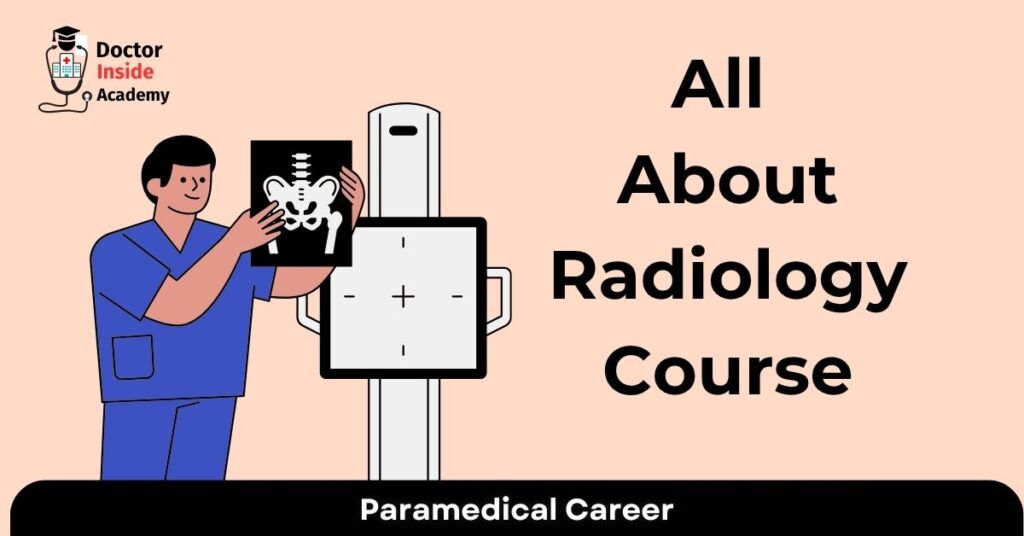Radiology is a diverse discipline that is developing continuously. It speeds up human development in all areas of technology, including health, diagnosis, and treatment. Since it is the foundation of the radiology department in the healthcare industry, a person known as a radiographer, the backbone of radiology, arises while addressing medical imaging technology.
In this in-depth guide, we will learn about who radiographers are, the different types of radiographers, their roles, salaries, duties, and much more.
Who is a Radiographer?
A radiographer is a paramedical practitioner who has completed their training in producing diagnostic images of the body’s internal organs or structures using medical imaging equipment. These diagnostic images will identify many medical disorders, diseases, or illnesses.
A radiographer can choose to specialize in X-rays, Computed Tomography (CT), Magnetic Resonance Imaging (MRI), or Ultrasonography (USG). To make sure patients get the best care possible, you work closely with physicians, radiologists, and other medical specialists. Your understanding of anatomy and medical terminology will allow you to position patients to capture the right diagnostic images in an effective way.
Role of a Radiographer
Many of the diagnostic images that radiologists make use of for diagnosing patient conditions are produced by the radiographer. Only the radiation required to create a high-quality diagnostic image must be monitored, and the patient’s body part must be positioned carefully.
It is important to highlight two important components of the radiographer’s job. While the second focuses on addressing patients’ needs in the medical field, the first one is about making use of technology professionally. Individuals of all ages, from small children to the elderly, get examined and treated.
Outside the radiology department, the radiographer works in a variety of settings, including patient rooms, cardiac care, emergency rooms, surgery, and critical care units.
Before performing a diagnostic test, radiographers generally capture patient history, including the patient’s personal information and medical history.
The radiologic technician offers a unique skill to help with illness and injury diagnosis.
Radiographers can use the following medical imaging modalities and procedures, are:
- CT Scanners
- Fluoroscopies
- PET Scanners
- Radiotherapy
- Ultrasonography
- X-rays
- MRIs
Different Types of Radiographers
There are specialized categories of radiographers based on their specific work and experiences, or their interests, in which they want to specialize.
So, here is a list of a few types of radiographers, are the followings:
X-Ray Technicians
These specialists are skilled in producing digital diagnostic images of the body and are commonly referred to as X-ray radiographers. They mainly operate in clinics, hospitals, and radiology centers.
Computed Tomography (CT) Technicians
These are the healthcare professionals who create body images using CT scans. Here, a computer and X-rays are used in CT scans to develop accurately detailed images of the human body for diagnostic purposes.
Mobile Radiography
Mobile radiography is the practice of conducting tests in hospital wards or at the patient’s residence using portable imaging equipment due to their medical conditions.
MRI Technicians
Using magnetic resonance imaging (MRI) technology to create images of the human body is your specialty as an MRI technician. These MRI scans use radio waves and a strong magnetic field to produce incredibly detailed images of the body.
USG Radiographers
Ultrasound technicians are experts in capturing high-frequency sound waves to create ultrasonic images. This technique can be used to create images of the body’s interior structures.
How to Become a Radiographer?
Here is a detailed procedure to become a radiographer, are:
Pursue Education and Training
You must first earn a degree in radiology and imaging technology or a diploma in RIT to work as a certified radiographer.
In India and the cities that are close to you, there are numerous radiology colleges. Additionally, this college places you in hospitals where you can gain real experience.
Since there are many health sciences colleges and universities in our area, get in touch with us to find out more about the paramedical college or institutions that are closest to you.
In addition to teaching radiography techniques, they also cover anatomy and physiology, radiation safety, medical ethics, lab and communication skills, patient placement, radiation physics, X-rays, nuclear medicine, and magnetic resonance.
Score Your Degree & Internship Letter
After receiving an associate’s or bachelor’s degree in radiography, people should begin working toward certification. They also need to finish their degree or diploma at the university where they were enrolled. Since you are no longer a freshman, you can also use your internship letter as a reference for your current position.
Try to capture letters of recommendation, also, if your training center agrees to these conditions. (it depends)
Apply for Jobs
After receiving all necessary certifications and letters, a radiographer can find employment in a wide range of settings, including hospitals, imaging centers, outpatient clinics, and mobile X-ray companies. The details of what a radiographer does daily depend on the specific job description for that profile.
Skills and Knowledge of Radiographers
You will require:
- Understanding of medicine and medical practices
- Sensitivity and awareness
- Understanding of biological processes
- Capacity to think logically
- Active listening abilities
- Focus
- Pay attention to detail
- Computing skills
- Knowledge of X-ray software
- Understanding of the procedures of radiography
Job Description for Radiographer
Here is the job description for radiographers, are:
Patient Preparation
Patients must be prepared for imaging procedures as part of your job, which includes placing them, describing the procedure, and making sure they are safe.
Operating Imaging Equipment
Using the right equipment to provide excellent images of the body’s interior parts is the primary responsibility of a radiographer.
Stay Updated on Imaging Equipment
Taking care of the devices you use is another part of your job. You take care of your equipment to keep it in good operating order.
Assessing Image Quality
After creating images of a patient, you evaluate the image quality and make any necessary corrections.
Collaboration with Doctors
Your ultimate goal is to provide physicians and other medical professionals with more details so they can deliver the best possible level of treatment. You discuss imaging findings and patient care frequently with doctors and other medical experts to help with this.
Day to Day Tasks of a Radiographer
You could do the following as a radiographer:
- Analyse body image data to identify illnesses and injuries
- Check for abnormalities
- Participate in biopsies and other surgical operations
- Collaborate with medical professionals
- Employ radioactive therapies such as X-rays
- Evaluate and keep track of patients throughout follow-up and therapy sessions
- Maintaining image quality
- Maintaining X-ray equipment/devices
- Getting patients ready and positioned for imaging
- Independently carrying out or supporting a certified professional in carrying out treatments like MRIs, X-rays, mammograms, or radiation therapy for cancer patients
- Medication preparation, administration, and documentation by medical or radiological policy, with state and federal laws.
Radiographers and radiologists: what’s the difference?
Radiographers and radiologists are both different entities, but work together to make the process faster and make the diagnosis effective with the proper care and medication for the same.
Here is a brief difference between a radiographer and a radiologist, are the following:
| Aspect | Radiologist | Radiographer (Radiologic Technologist) |
| Education | Medical degree (MD or DO) with specialized radiology training | Bachelor’s or associate’s degree in radiologic technology or radiography |
| Role & Responsibilities | Interprets medical images, diagnoses medical conditions | Performs imaging procedures, operates imaging equipment |
| Certification/License | Certified as a medical doctor, often with radiology board certification | Certified or licensed as a radiologic technologist |
| Patient Interaction | Minimal direct contact; focuses on diagnosis and consultation | Direct contact explains procedures and ensures patient safety |
| Work Environment | Hospitals, clinics, private practices, academic centers | Hospitals, imaging centres, clinics, diagnostic labs |
| Scope of Practice | Diagnosing, analyzing images, and recommending further tests | Performing imaging procedures accurately and safely |
| Work Focus | Medical diagnosis and interpretation of images | Technical operation of imaging equipment and patient positioning |
,
Reasons to See a Radiographer
You need to see a radiographer for medical imaging if you:
- Have a broken bone
- Have a blocked artery or other vessel
- Have a foreign object in your body
- May have a tumor or cancer
- Tear a muscle
You’ll most likely see a radiologist or a radiologic technologist, after a recommendation from another doctor, which may be your primary care doctor or a specialist like an orthopedist.
Salary of a Radiographer
A radiographer typically makes around ₹310,432 a year, according to Payscale. This average takes into account several perks, such as plans for profit sharing and rewards. The salary range for this occupation is more vast. Fresh Radiographers at the beginning of their careers, for instance, can earn up to ₹276,000 annually, while experienced radiographers can earn up to ₹600,000.
Experienced radiographers generally earn more money than those who are just starting their careers in the radiology field. This is because experienced radiographers have extensive knowledge and expertise over time and are capable of working independently.
Radiographers who specialize in a specific imaging modality, like CT or MRI, could be paid more than those who don’t.
You may also be compensated accordingly depending on where you work. Compared to radiographers working in rural or suburban settings, those who work in major cities or metropolitan areas often make more money.
FAQ
Is Radiography a Good Career in India?
The growing need for advanced diagnostic imaging in healthcare is driving the fast growth of the radiology profession in India, which presents promising opportunities. There is an acute demand for qualified radiology experts due to the development of hospitals, diagnostic centers, and teleradiology services.
What is the Qualification of a Radiographer?
He must have a degree or diploma in radiology and imaging technology from a university recognized by the UGC.
How Long Does it Take to Become a Radiographer?
It takes a minimum of 2 years to become a radiographer based on the diploma and about 3.5 years based on an undergraduate degree.
How can I become a Radiographer after the 12th?
You can work as a radiologist in either public or private healthcare facilities by obtaining a B.Sc. in radiology and imaging technology. After the 12th, you can pursue a degree or diploma course in radiology imaging technology.
Can a Radiographer Diagnose?
To better understand and diagnose diseases, diagnostic radiographers use advanced equipment to obtain images of patients’ internal organs. A radiographer can discuss it with the radiologist first.
What skills do I need to be a radiographer?
A radiographer must have accuracy, care, attention to detail, and a willingness to stay updated with technological advancements in the radiology field.



Hello, friend!
doctorinsideacademy.com, Thanks for keeping a thoughtful corner of the internet alive.